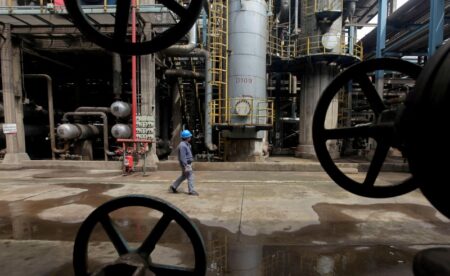By Simon Jessop
LONDON (Reuters) – Morgan Stanley has lowered its expectations for cutting emissions from its corporate lending portfolio as the world is moving too slowly to a greener economy, the bank’s chief sustainability officer told Reuters.
A slowdown in electric vehicle sales, lagging adoption of biofuels in aviation and funding and policy hurdles in the power sector were just some of the factors hampering progress, Jessica Alsford said.
While banks such as Dutch firm ING have trimmed lending to some clients, for example in the Oil and Gas sector, Morgan Stanley said in a report laying out its new targets it was mindful of not doing so too quickly.
Yet, unless the pace of change picks up, its clients and the firm itself “may not meet net-zero-aligned targets”, it added.
Given the backdrop, its lending approach would now aim to be in line with capping global warming at 1.5 to 1.7 degrees Celsius, softening a previous target of a straight 1.5 degrees, the bank’s first major climate update in three years showed.
“The current technologies, the current policies are not fully aligned with 1.5 degrees, and by having that range of 1.5 to 1.7 it’s acknowledging the challenges that the global economy faces whilst being aligned, still, with the Paris Agreement,” Alsford said.
The Paris Agreement aims to cap the average increase since industrial times well below 2 degrees by 2050.
Despite record temperatures across the planet, many companies’ emissions continue to rise and a U.N. report on Thursday showed the world’s average temperature increase was currently on course to hit 3.1 degrees by 2100.
SECTOR RANGES
Alsford said Morgan Stanley would now have emissions reduction targets by 2030 for six sectors – Energy, Power, Autos, Chemicals, Mining and Aviation.
The bank also reset the baseline from which the targets would be measured to 2022 from 2019, because the more recent year had much better data, Alsford said.
It would also adopt a so-called “physical intensity” methodology that tracks emissions per unit of, for example, production or generation, Alsford said, bringing the bank into line with peers and clients.
Under the new plan, the bank said it would now track the Energy sector emissions using two targets, one for the so-called Scope 1 and 2 emissions, those from the company’s operations and energy use, and one for Scope 3, when their products are used.
The sector’s operational emissions were targeted to fall 12-20% by 2030, with end-use emissions down 10-19%, although the bank said issues including energy security pressures could impact results.
Power sector emissions across its lending portfolio were targeted to fall between 45-60%, although funding and policy support would be needed to meet rising demand, including that required by artificial intelligence technologies.
Autos were targeted to fall 29-45%, although the bank warned electric vehicle adoption rates were lagging the rate needed to meet the sector’s share of the global target.
In the Aviation sector, emissions were targeted to fall 13-24%, driven by use of sustainable aviation fuel. While the IEA has said this should hit 10% by 2030, the bank noted some airlines were only targeting usage of 5-7.5%.
“There remain significant challenges ahead to ensure that supply can meet demand at cost parity, which will be a key determinant for airline companies to achieve their interim emission reduction targets and thus for us to achieve our own aviation target,” the bank said.
Chemical sector emissions were targeted to fall 18-28%, although results will depend on scaling nascent technologies including green hydrogen and capturing and storing emissions.
For the Mining sector, the bank said it hopes to cut portfolio emissions by 23-31% by actions including boosting the use of renewable power.
Read the full article here
















